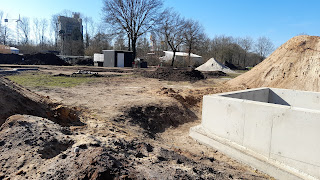Today we started a test at the TU Delft Green Village to measure the performance of a solar panel combined with a green roof with endemic species, vs. solar panels without a green roof. I installed the metergroup's sensors ATMOS 14 and a datalogger to measure air temperature, humidty and air pressure above and below each of the two setups. Here you can see some photos of the installation groups and the sensor setup. Big thanks to the TU Delft Green Village team who helped us out on the spot by creating two pole setups to place sensors just above the solar panels, complete with tiles against blowing over by the wind. I have high confidence these sensors will survive any upcoming storms and wind gusts.










In addition, we have access to data from a weather station on the building, soil moisture and soil temperature sensors from Dakbloemenweide, and infraredsensors for the temperature of the roof itself. So far, we are getting data to our cloud. Our goal is to measure from April 1st to March 31st next year. We expect that especially in summer the evapotranspiration of the vegetation in the green roof will help reduce the maximum temperatures experienced by the solar panels and that they thereby are closer to their ideal operating temperature of 25 C, and can produce more electricity than the solar panels without a green roof. Especially since this roof is covered by black bitumen, which can quickly heat up dozens of degrees Celsius higher than the air temperature on ground level in shade.
The newsletter from the main organizing implementation partner Dakbloemenweide already reports on this initiative (in Dutch).































